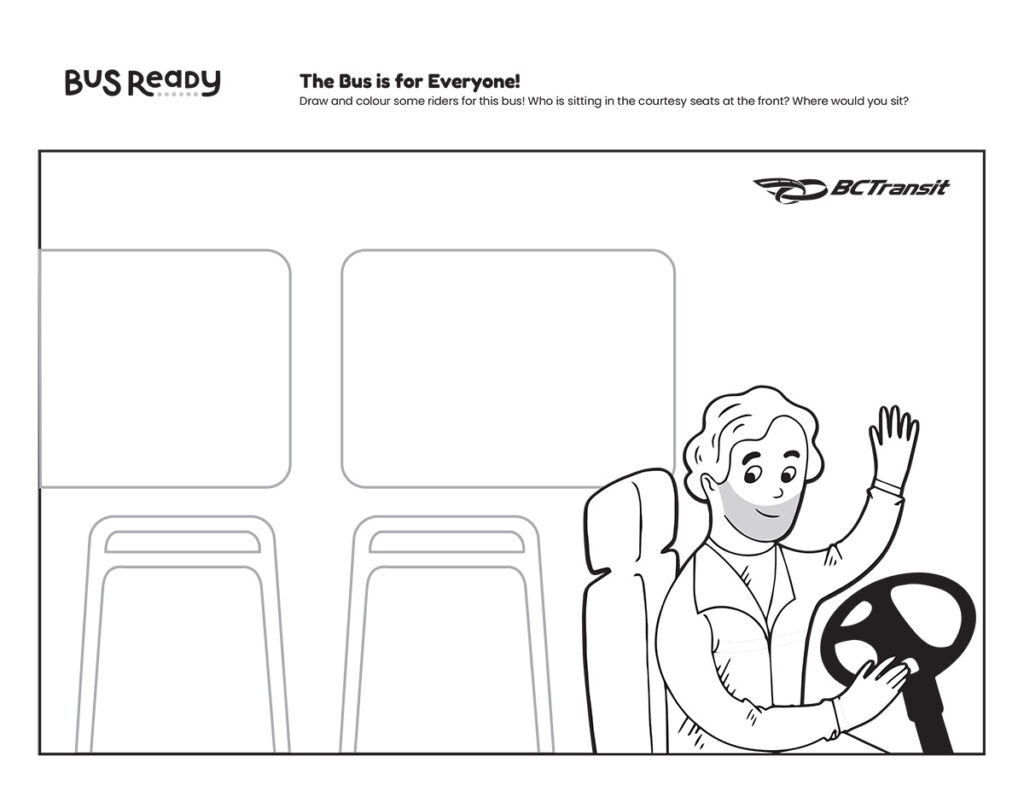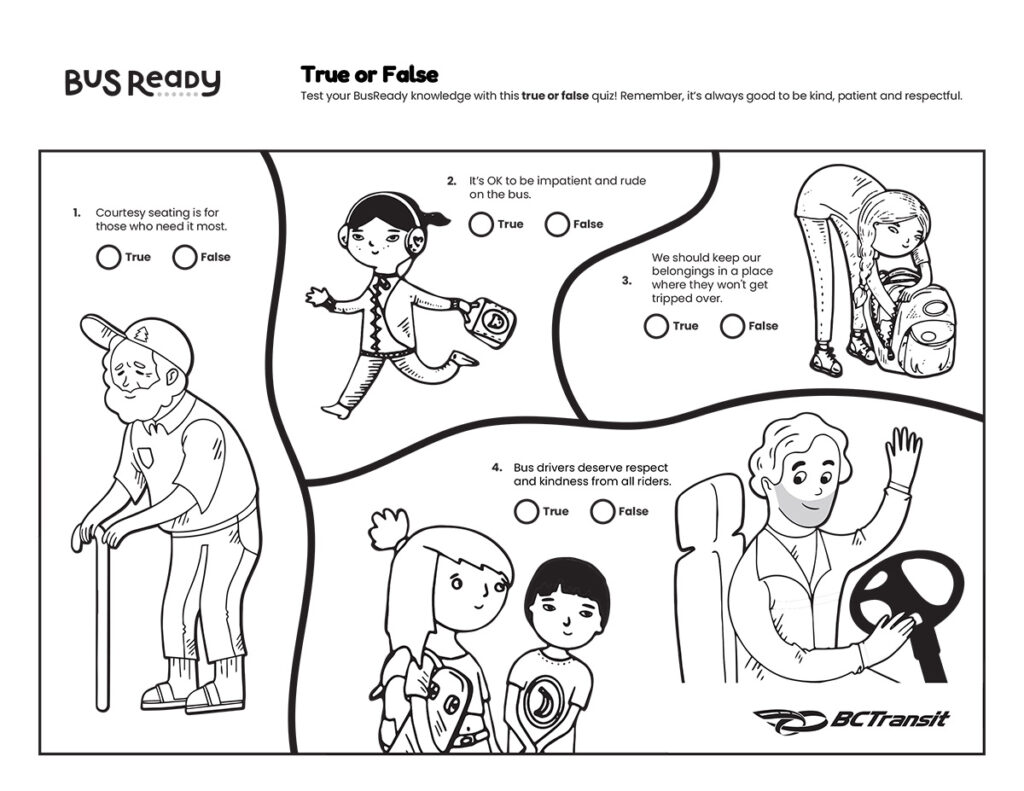Educational Resources
BusReady Lesson: Everyone Belongs on the Bus
Everyone Belongs on the Bus
- Topic: Accessibility, Inclusion
- Activity Type: Discussion, Thought Starter, Critical Thinking and Motor Skills
- Grades: Kindergarten – Grade 3
- Duration: 30-35 minutes. Duration may depend on how detailed children want to be.
Overview
Students will learn about the importance of accessibility and inclusion in public transit. They will understand what accessibility and inclusion means and how these concepts relate to riding the bus. The lesson will highlight why it is crucial for everyone in the community, including people with disabilities, seniors, parents with strollers and those who may not drive, to have access to safe and welcoming public transportation. Students will engage in activities that promote social awareness and responsible decision-making, contributing to a more inclusive community.
What you’ll need
- The Bus is for Everyone downloadable activity
- True or False downloadable activity
- Access to a whiteboard, or paper for creating a mind map
- Coloured pencils or markers.
Instructions
Kindergarten – Grade 1
Discuss the following in your class.
Introduction
- Start by asking students what they know about accessibility and inclusion. Write their ideas on the board.
- Discuss why accessible and inclusive transit is important for us all. Feel free to use or modify the statement below with your classroom.
Accessibility and inclusion are important on the bus because they make sure that everyone can ride safely and comfortably. This means that people with disabilities, older people and parents with strollers can use the bus just like everyone else. When the bus is welcoming for everyone, it helps us all feel included and happy. It also means that everyone can get to the places they need to go, like school, parks and shops. By making the bus a place for everyone, we show that we care about each other and want to help everyone in our community.
Accessibility Video
Show your students this video to better explain the concept of courtesy seating on public transit buses.
Be a BusReady Bus Buddy
Have a discussion with your students to identify and understand smart choices and behaviours on the bus through interactive scenarios. After saying each scenario, ask them to say out loud if it’s a “Good Idea” or a “Bad Idea” or do a simple thumbs up or thumbs down.
Discuss each answer briefly, explaining why it is a good idea or a bad idea and how being a good BusReady Bus Buddy emphasizes accessibility and inclusion.
Optional: Act out these scenarios in class!
Scenarios
| Good Idea | Bad Idea |
|---|---|
| Offering your seat to someone who uses a wheelchair or has difficulty standing. Why? It’s kind and helps others feel included. | Blocking the aisle by putting your backpack in the middle of the walkway. Why? Other riders may trip on your bags, causing them to fall and get hurt! |
| Letting someone with a baby stroller on or off the bus first. Why? Because the adult has a stroller, it may be harder for them to find a seat, or make their way off the bus. | Leaving garbage on the floor or seats of the bus. Why? A dirty bus makes the space unpleasant for other riders. It’s our responsibility to keep the bus clean as best we can when we ride the bus. |
| Speaking politely and using kind words with all passengers. Why? Being kind is cool, makes you a good friend and makes you a great BusReady Bus Buddy. | Talking loudly or making loud noises while you’re on the bus. Why? It’s important to be quiet so the driver can focus on the road, and so the riders can relax during their ride. |
| Waiting patiently for someone who uses the accessibility ramp to exit before you get on the bus. Why? Giving people time and space to exit the bus safely is a kind thing to do. | Running down the aisle of the bus. Why? Running down the aisle isn’t safe because you could trip and hurt yourself or other riders. |
The Bus is for Everyone
Have your students draw themselves plus anyone who they think might need courtesy seating while on the bus.
Once finished, consider exploring the virtual tour of a real BC Transit bus on our website to help children cognitively situate themselves on the bus.
- One worksheet per student.
- Have students draw and share who they would ride the bus with!
Instructions
Grade 2-3
Discuss the following in your class.
Introduction – Mind Map Activity
- Draw a mind map on the board exploring different needs that people might have when using the bus.
- Ask students to think about the difference between visible disabilities (e.g. someone who uses a wheelchair or other mobility challenges) and invisible disabilities (e.g. someone with a visual impairment or a brain injury). This may be a good opportunity to discuss with your classroom how some people have disabilities that you can see, like using a wheelchair, while others have disabilities you can’t see, like needing extra time to understand things.
- Encourage students to consider other needs, such as those of seniors, parents with strollers and fellow children who may be younger or need assistance.
Read Aloud Opportunity
Accessibility and inclusion are important on the bus because they make sure that everyone can ride safely and comfortably. This means that people with disabilities, older people and parents with strollers can use the bus just like everyone else. When the bus is welcoming for everyone, it helps us all feel included and happy. It also means that everyone can get to the places they need to go, like school, parks and shops. By making the bus a place for everyone, we show that we care about each other and want to help everyone in our community.
- Discuss making the bus welcoming for every rider. Because accessibility and inclusion are important, ask students to suggest ways to make the bus more welcoming and comfortable for everyone. Write their ideas on the mind map.
- Discuss accessible areas such as wheelchair ramps and courtesy seating and why it is important to treat these areas with respect.
Accessibility Video
Show your students this video to better explain the concept of courtesy seating on public transit buses.
Class Activity – Do’s and Don’ts
Read out a statement below and ask your class if they think it’s on the “Do” list or the “Don’t” list.
| Do | Don't |
|---|---|
| Offer Your Seat Courtesy seats are for people who need them the most. If you are sitting in a courtesy seat and you see someone board the bus who may need it more, offer your seat, it’s the right thing to do. | Block Accessible Areas Avoid standing or placing your bags or items in areas reserved for people with disabilities, such as wheelchair spaces and courtesy seating. |
| Be Patient and Helpful Give people with disabilities extra time to get on and off the bus. Offer help if they look like they need it, but always ask first. | Assume Help is Needed Never assume someone needs your help. Always ask first and respect their response. |
| Follow the Rules Learn the rules of the bus and follow them. Listen to the driver’s instructions to keep everyone safe and comfortable. | Rush or Push on the Bus Be patient and avoid rushing or pushing others when boarding or exiting the bus, especially those who may need extra time. |
| Talk to the Bus Driver If you or someone else needs help, please do not hesitate to ask the driver for assistance. They are a safe stranger whose job it is to keep the bus safe. | Stare or Point Treat everyone how you want to be treated. Staring or pointing at someone because they have a disability or are different than you is unkind. Be respectful! |
True or False Quiz
Give your students the downloadable “True or False” activity sheet. This will reinforce their understanding of how to make the bus more welcoming for all by checking the true or false answers.
The Bus is for Everyone
Have your students draw themselves plus anyone who they think might need courtesy seating while on the bus.
Learning Objectives
- Understand the importance of accessibility and inclusion in public transit and every day life.
- Practice empathy towards individuals with diverese needs in the community.
- Apply critical thinking skills to identify ways to improve inclusivity on public transit.
- Apply social emotional skills to identify ways to improve inclusivity on public transit.
Core Competencies
Communication, collaboration, critical, reflective thinking and social emotional skills are at the forefront in this lesson.
Critical and Reflective Thinking
- Students will generate ideas and reflect on their understanding of accessibility and inclusion.
- They will engage and explore questions to deepen their understanding of the needs of diverse transit riders.
Commnication and Collaboration
- Acquiring knowledge through discussions and interpretations about accessibility and inclusion from peers.
- Engaging in inquiry and discussion to understand diverse perspectives on how public transit serves the community.
Extensions & Modifications
Interactive Bus Tour
Help students familiarize themselves with the bus by visiting BusReady’s virtual bus tour. Older students will be capable of self-led exploration while younger students may require guidance.
Role Play
For students who may be eager to do more, consider having them roleplay different scenarios in which people with diverse needs would be accommodated using our accessibility features.
Assessment
- Assess each student’s understanding of what accessibility and inclusion mean and their importance on the bus.
- Assess student’s ability to identify and empathize with those who may have visible and invisible disabilities.
- Assess student’s participation in the mind map activity and their suggestions for making the bus more welcoming.
- Review the colouring sheets and quiz answers to ensure they have correctly identified the right thing to do.

